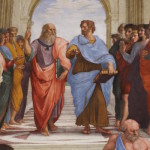How We Know the Human Soul is Immortal
by Dr. Dennis Bonnette
Filed under Man

In a 2015 video, I facetiously argued that, based on his own philosophical assumptions, Dr. Richard Dawkins does not actually exist. Of course, I firmly believe he does. But, my point was that, given his view of the universe, in which things are merely interacting aggregates of subatomic particles, there is no place for substantial unities above the level of whatever ultimate particles compose the cosmos.
A substantial unity is a thing whose entire nature is the same throughout. Every part of it has the same nature. The nature of my foot or stomach is not “foot” or “stomach,” but “human,” since my entire being shares the same human nature.
I will demonstrate that human beings are substantial unities. Only then can one rationally discuss whether we, as living substances, have spiritual and immortal souls. Since it is materialists who primarily reject the human spiritual soul, I shall address my comments primarily to their objections.
Cartesian Catastrophe
Sixteenth century philosopher, René Descartes, grafted a spiritualist view of the human person onto a materialist-mechanistic view of the human body. Typically understood as maintaining that mind (res cogitans) and body (res extensa) are two entirely distinct entities, this doctrine raises grave problems for any rational explanation of soul and body interaction. Such a radical distinction between mind and body is referred to as extreme dualism. Historically, this extreme dualism led to diverse philosophies such as transcendental idealism and positivism.
The Aristotelian-Thomistic view of man’s nature rejects Cartesian dualism. I shall offer arguments for the hylomorphic (matter/form) nature of man, which simultaneously refute (1) Cartesian extreme dualism and (2) the atomistic view (like Dawkins).
Why Man is a Single Substance
Basic metaphysics reveals that, just as non-being cannot beget being, activity (being, as proceeding from something) must manifest nature (the way something exists).
The standard argument for an organism’s substantial unity is that, since all its parts act for the good of the whole, rather than just merely for themselves, it must be because they are in fact parts of a whole. The function of a stomach or foot is not to care for itself, but rather to serve the good of the whole organism. Indeed, the liver “sacrifices” itself detoxifying all the poisons we ingest, for example, alcohol – even to the point of its own destruction. The intelligibility of a part, as a part, cannot be understood except that it is part of a whole.
“Actions for the sake of the whole” are manifested through multiple levels in the case of reproduction and development of organisms, for example, a human being.
At the moment of conception, the newly formed, single-celled zygote contains all the organs needed to keep this new, unbelievably-tiny human being alive. At the same time, all the genetic material within the zygote is co-acting so as to govern its development in precisely such fashion as to produce the next stages together with all the changes which will still entail each organ serving the whole of the organism at that later stage of life. Finally, this whole process, at each and every stage of its development is ordering all its parts to the production of the adult human being, in which, again, all of his organs will be acting for the sake of his being a complete and functioning living adult human being. Thus, at every moment in his development, the internal forces at work within the human organism are acting to assure the survival and function of the organism as a whole – both in the moment at hand, at every subsequent stage in its development, and simultaneously – from the first moment of its existence – to assure the well-being of the entire adult human being.
While the above argues forcefully for the human organism’s substantial unity, even more striking evidence abounds for that unity as we wholistically experience our personal interaction with the physical world.
Direct experience of the world tells us that “incoming” data are flooding our consciousness -- data that presents itself as a direct encounter with physical reality. We experience this through our five external senses of hearing, tasting, smelling, touching and seeing.
These sense data represent “incoming fire” from the various external senses – which we receive and unify into a total sensible experience of a real physical world filled with unified objects, such as an attacking vicious canine. The oneness of our own being is manifest in the unity of our experience as the subject being physically mauled.
But it does not end there. We also react to the world by marshalling all our various powers of thought and will and motor skills to react to the incoming data in a manner largely under our control and directed by our will commanding various mental and physical acts. We react to the world with our whole being, all parts acting together to produce a unified reaction to the external data. Thus, we respond with all the various powers of our being – mental and material – to drive this attacking canine away. Not away from just our mind, or hand, of foot, or whatever part of the body is most directly involved – but from our entire being, all parts being simultaneously engaged to bring all our various spiritual, mental, and physical parts and powers into the action of defending our whole selves against this viciously attacking dog.
This is not the mere internal images or ideas of Cartesian thought thinking itself, but the lived experience of a self -- unified in mind and body, experiencing external reality as a whole and reacting as a whole to engage and repel a dangerous external attacker.
That is the reason why everyone is so instinctively certain that he but a single being, with both mind and body, existing as a unified substance interacting with a real physical world.
Some reason for the unity of the whole self must be posited. Such a reason, according to Aristotelian-Thomistic philosophy, would be the substantial form, or soul, which animates the entire organism to be and to act as a single substantial unity.
In response to all this, the materialist might still object that everything I have described could just as well be explained in purely atomistic terms – as responses of complex biochemical systems to external stimuli. But the key to refuting that claim is the simplicity of the experience of wholeness that permeates the entire sequence of experiences described above.
“Wholeness” of Experience Reveals Immateriality, But Not Spirituality, of the Soul
Metaphysical materialism cannot explain how cognition unifies, in a single simple act, what, physically, is extended in space and multiple in parts. The essential insight, as I more fully explain in another Strange Notions article, is that purely physical things can never apprehend the “wholeness” of an experience for the simple reason that physical representations are always extended in space. They always “image” something by having one part represent one part of the object and another part represent another part – with no single part representing (apprehending) the whole.
The most obvious example is a TV screen on which an image of an object is presented – one pixel at a time by hundreds of thousands of pixels – each one digitally “on” or “off,” but with no single pixel “seeing” the whole. The screen sees nothing. But, a living, sensing dog looking at the screen can see the image of another whole dog and bark at it. Why? Because the dog, unlike purely material things such as a TV screen, has something not extended in space, which enables it to apprehend the image as a single whole. Specifically, the dog has immaterial sense powers.
That is why machines sense nothing -- and no computer will ever understand the synthetic wholeness expressed in the intellectual judgment, “Cogito, ergo sum.” An aggregate of mere physical parts can never experience anything as a whole. Yet, that is precisely what can be done by animals and men. Even a dog, which has no spiritual soul, perceives another dog as a whole. Still, I am not saying that this “immateriality” in cognition is the same thing as “strict immateriality,” that is, spirituality. But, I am saying that what is immaterial is neither extended nor locatable in space.
Some modern materialists are puzzled by “qualia,” properties of experience that are not physically detectable, yet subjectively real. But anything genuinely physical must be locatable in space. Either qualia are locatable or not. If they are, then they are merely material. If not, then immaterial things exist. But clearly, experiences of “wholes” are not locatable in space, as shown above. Genuine immateriality is real – and physical reality cannot account for it, since non-being cannot account for being. What is locatable in space cannot account for what is not locatable. The reality of experiences of wholes is incompatible with a purely atomistic metaphysics.
What is clear in the example given earlier is that we experience as a whole both the incoming sensory data of the various cognitive faculties as well as our unified cognitive and motor response to that same data -- as in that hypothetical confrontation with a vicious dog. Since (1) solely an immaterial principle can apprehend such “wholes” and (2) the entire cognitive and motor acts of the person are apprehended as a functioning whole in such situations, it follows that an immaterial principle, which is what we know on reflection as the “self,” is at the very center of our functional operations as a human being confronted by, and reacting to, the external physical world.
This principle, which unifies (1) the activity of the sense organs, (2) sensation itself, and (3) all the intellectual activities of man into a functional whole, must not only be immaterial, but must account for the living human organism acting and being as such a whole, since we immediately experience both (1) the passive awareness of external objects acting upon us and (2) our personal direction of our coordinated faculties in active response to such objects. Since mere atomistic material components lack all immateriality, atomistic explanations fail to explain adequately the unifying and immaterial aspects of human cognitive and physical interaction with the world.
Because we experience sense objects under their proper material conditions, that is, as with particular height, width, color, shape, and so forth, it follows that the soul has at least some activities intrinsically dependent on matter and using material organs – thereby manifesting that it is not simply the pure mind or spirit that Descartes’ extreme dualism alleges.
Aristotle’s doctrine of hylomorphism maintains that various types of things are composed of form and matter, where (1) form specifies the matter to be the kind of thing that it is and (2) matter quantifies and individuates the form into a particular instance of the form. Aristotle attributes human acts, such as described above, to the form of the substance – the substantial form, which he also calls the soul. The soul is the unifying life principle of all organisms.
From the points made above, it should now be evident that (1) atomism is false, because it fails to account for the immateriality of cognition, and (2) extreme dualism is false, because it fails to note the dependence of sense experience on matter. Since the extreme alternatives of atomism and extreme dualism are both false, hylomorphism becomes the intermediate default position, which must be the true doctrine.
Spiritual Nature of Intellectual Acts
Nonetheless, the human intellect manifests other operations demonstrably totally independent of matter – actions such as self-reflection, understanding, judging, and reasoning. Since lack of space prevents explanation of why all these acts are strictly immaterial, I shall present just one argument, based upon the radical difference between the image and concept.
Eighteenth century Scotch sceptic, David Hume, failed to grasp the essential difference between the image and the concept. Hume maintained that all we know are sense impressions. What we take to be external sense experience he describes as vivid and lively sense impressions. Ideas are taken from memory or imagination and are less vivid. All knowledge remains at the sensory level. So, too, for modern materialists, all knowledge, whether direct sensation or “intellectual” ideas, is merely sensory in nature, and thus essentially mere neural activity and patterns ultimately based in the brain. Ideas or concepts are not qualitatively superior to sense impressions or images. Sensism reigns supreme.
But for Aristotelian-Thomistic classical philosophy, image and concept (idea) are radically distinct entities. Sense impressions or images are either mere neural patterns or dependent on them. In any event, being radically immersed in matter, they are expressed under conditions of time and space. This means that they are always singular, particular, concrete, and having material qualities, such as shape, color, size, and so forth, which make them imaginable. Thus, one can imagine a horse or triangle, but always with a particular shape, color, size, and so forth. Recall, this was how we knew that the immateriality of sense knowledge was not actually spiritual in nature, since its object was always under the conditions of matter, and therefore, did not exhibit total independence of matter.
On the contrary, the universal concept or idea utterly transcends all material conditions. Thus, horseness or triangularity is not even imaginable. Because universal concepts must apply to each and every possible concrete actualization, they can express the concrete physical characteristics of none of them. Thus, “triangularity” must express every possible triangle’s essence – be they obtuse, acute, or isosceles. That is why idealized sculptures of something like “triangularity” never express every single possible triangle, but only some idealized, but concrete, representation of the concept. So, too, there is no concrete ideal of “horseness,” since it must express the essence of every possible concrete horse. Indeed, some concepts are directly of spiritual entities which inherently cannot be physically expressed, such as justice, beauty, truth, oneness, and so forth.
The fact that the human intellect can form such spiritual entities, demonstrates the spirituality of the human soul, since the less perfect cannot produce the more perfect.
Nominalists claim that no such universals exist, but are rather merely names for multiple associated things. Yet, ultimately, there is no way to know which items should share the same predicate unless one already sees what is common in nature to them. More strikingly, no matter how we form them, the irreducible difference between image and concept remains evident as shown above.
And yet, if universal concepts reveal the spiritual powers of man, how is it that animals seem to recognize the common qualities of sense objects, as when the wolf knows all sheep? Such knowledge is not that of a universal concept, but merely a “common image,” whereby similar sensible qualities are perceived as similar in a singular image. It does not prove universal understanding of the nature involved, but merely a response to sensible similarities through the common image. The fact that an animal responds in a common way is no more impressive than that a computer can be programmed to respond to similar sensible objects, since (1) the computer knows nothing and (2) the human understanding of the universal concept remains radically incommensurable with mere knowledge of an image. My article on ape-language studies explains this entire subject in far greater detail than is possible in this short piece. Suffice it to note that for a cat to know the common image of a mouse has far more utility than would be the intellectual understanding of the internal essence – even though a human biologist would prefer the latter.
Because sense knowledge is always dependent on the individualizing, concretizing nature of matter, nothing spiritual is evinced by the animal kingdom. But, the fact that man can form and understand universal concepts free of all such conditions of matter reveals the spiritual nature of human intellectual operations, and thereby, the spiritual nature of the human soul. Since the human soul is free and independent of matter, it must have existence independent of matter as well. Therefore, the separation of that spiritual soul from the material body at death does not entail the end of life for the human person. Man dies, but his spiritual soul is immortal.
Since some operations of the soul are dependent on matter and some are clearly independent of matter, it follows that the human soul is a hylemorphic principle – neither totally separated from the human substance in life, nor yet so existentially dependent upon that composite substance as to be destroyed at death.
Unlike extreme Cartesian dualism, Aristotelian-Thomistic philosophical psychology recognizes the intrinsic relation of the human soul to the whole of man’s being. The fact that the soul integrates both material sensation and spiritual intellection in the same psychic human acts shows that it must be, not a totally separated spirit during life, but rather the substantial form of the living human being. Yet, that substantial form is a hylemorphic principle whose spiritual operations and nature enable it to survive the death of the whole man so as to assure immortal life for the human person.
Whether that form is reunited to a material principle through a resurrection process belongs to the science of theology rather than philosophy. Still, the natural ordination of the form to matter suggests the possibility of a future resurrection.
Related Posts
Note: Our goal is to cultivate serious and respectful dialogue. While it's OK to disagree—even encouraged!—any snarky, offensive, or off-topic comments will be deleted. Before commenting please read the Commenting Rules and Tips. If you're having trouble commenting, read the Commenting Instructions.












